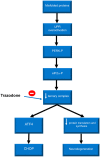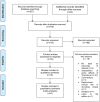The effects of trazodone on human cognition: a systematic review
- PMID: 34097124
- PMCID: PMC8182348
- DOI: 10.1007/s00228-021-03161-6
The effects of trazodone on human cognition: a systematic review
Abstract
Trazodone is a widely used antidepressant that is also useful in the control of agitation and insomnia in Alzheimer's disease. This drug is now recognized as having a new mechanism of action, an effect on the unfolded protein response (UPR) pathway, restoring protein translation and slowing neurodegenerative progression in mice. This mechanism may have a role in dementia-modifying treatment. To explore the effects of trazodone on human cognition and to search for clinical evidence of its putative benefits in human neurodegenerative diseases, a systematic review was conducted for studies that evaluated the effect of a minimum dose of 25 mg of trazodone daily, for at least 1 week, on cognition in adult humans. The search was run in MEDLINE, Web of Science, and CENTRAL from the Cochrane databases, yielding a total of 16 studies after selection. Overall, seven studies showed no effect of trazodone on cognition, five showed a beneficial effect by improving or reducing cognitive decline, and four evidenced impaired cognitive function. Our analysis highlights the possibility of a dose-independent dual effect of trazodone on human cognition, with acute utilization associated with impaired cognitive function and long-term use with preventing cognitive deterioration. There was no clinical evidence that trazodone could be used as a specific treatment of neurodegenerative diseases. Future studies should explore the role of trazodone in the UPR pathway and the implications in neurodegenerative diseases in humans.
Keywords: All cognitive disorders/dementia; Alzheimer's disease; Executive function; Memory; Trazodone.
© 2021. The Author(s), under exclusive licence to Springer-Verlag GmbH Germany, part of Springer Nature.
Conflict of interest statement
The authors declare no conflict of interest.
Figures


Similar articles
-
Long-Term Trazodone Use and Cognition: A Potential Therapeutic Role for Slow-Wave Sleep Enhancers.J Alzheimers Dis. 2019;67(3):911-921. doi: 10.3233/JAD-181145. J Alzheimers Dis. 2019. PMID: 30689583 Free PMC article.
-
[Trazodone--its multifunctional mechanism of action and clinical use].Neuropsychopharmacol Hung. 2010 Dec;12(4):477-82. Neuropsychopharmacol Hung. 2010. PMID: 21220793 Review. Hungarian.
-
Clinical guidance for the use of trazodone in major depressive disorder and concomitant conditions: pharmacology and clinical practice.Riv Psichiatr. 2019 Jul-Aug;54(4):137-149. doi: 10.1708/3202.31796. Riv Psichiatr. 2019. PMID: 31379379 Review.
-
Off-Label Trazodone Prescription: Evidence, Benefits and Risks.Curr Pharm Des. 2015;21(23):3343-51. doi: 10.2174/1381612821666150619092236. Curr Pharm Des. 2015. PMID: 26088119 Review.
-
A review of trazodone use in psychiatric and medical conditions.Postgrad Med. 2017 Jan;129(1):140-148. doi: 10.1080/00325481.2017.1249265. Epub 2016 Oct 28. Postgrad Med. 2017. PMID: 27744763 Review.
Cited by
-
DOTA: Deep Learning Optimal Transport Approach to Advance Drug Repositioning for Alzheimer's Disease.Biomolecules. 2022 Jan 24;12(2):196. doi: 10.3390/biom12020196. Biomolecules. 2022. PMID: 35204697 Free PMC article.
-
Efficacy of donepezil versus donepezil and trazodone in combination cognitive dysfunction in patients with dementia: a randomized controlled trial.Naunyn Schmiedebergs Arch Pharmacol. 2025 Jun 30. doi: 10.1007/s00210-025-04329-y. Online ahead of print. Naunyn Schmiedebergs Arch Pharmacol. 2025. PMID: 40586866
-
Different Effects of SSRIs, Bupropion, and Trazodone on Mitochondrial Functions and Monoamine Oxidase Isoform Activity.Antioxidants (Basel). 2023 Jun 2;12(6):1208. doi: 10.3390/antiox12061208. Antioxidants (Basel). 2023. PMID: 37371937 Free PMC article.
-
History of Psychoactive Medication a Risk Factor for Neurocognitive Decline After Cardiac Surgery.J Surg Res. 2024 Mar;295:414-422. doi: 10.1016/j.jss.2023.11.009. Epub 2023 Dec 8. J Surg Res. 2024. PMID: 38070255 Free PMC article.
-
Managing Sleep in Adults with ADHD: From Science to Pragmatic Approaches.Brain Sci. 2021 Oct 16;11(10):1361. doi: 10.3390/brainsci11101361. Brain Sci. 2021. PMID: 34679425 Free PMC article. Review.
References
-
- Halliday M, Radford H, Zents KAM, Molloy C, Moreno JA, Verity NC, Smith E, Ortori CA, Barrett DA, Bushell M, Mallucci GR. Repurposed drugs targeting eIF2α-P-mediated translational repression prevent neurodegeneration in mice. Brain J Neurol. 2017;140(6):1768–1783. doi: 10.1093/brain/awx074. - DOI - PMC - PubMed
-
- Ashford JW, Miller TW. Effects of trazodone on sleep in patients diagnosed with post-traumatic stress disorder (PTSD) J Contemp Psychother. 1996;26(3):221–233. doi: 10.1007/BF02307588. - DOI
Publication types
MeSH terms
Substances
LinkOut - more resources
Full Text Sources
Medical

